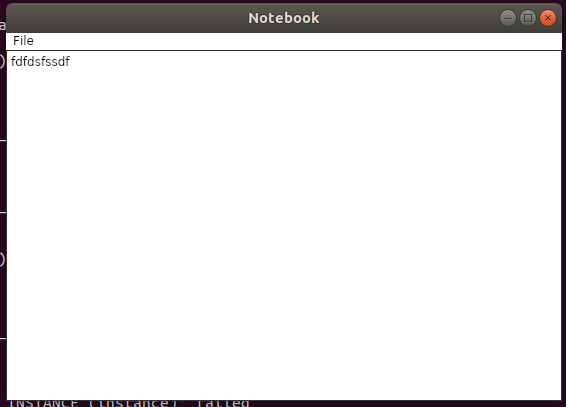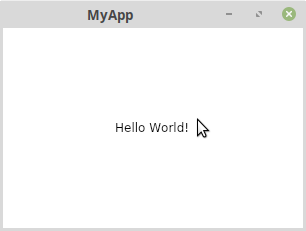Install
The best place to get started with Avalonia is by creating an application using a template.
To install the Avalonia templates, run the following command:
dotnet new install Avalonia.Templates For .NET 6.0 and earlier, replace install with —install
To list the installed templates run
You should see the installed Avalonia templates:
Template Name Short Name Language Tags -------------------------------------------- -------------------------- ---------- --------------------------------------------------------- Avalonia App avalonia.app [C#],F# Desktop/Xaml/Avalonia/Windows/Linux/macOS Avalonia MVVM App avalonia.mvvm [C#],F# Desktop/Xaml/Avalonia/Windows/Linux/macOS Avalonia Cross Platform Application avalonia.xplat [C#],F# Desktop/Xaml/Avalonia/Web/Mobile Avalonia Resource Dictionary avalonia.resource Desktop/Xaml/Avalonia/Windows/Linux/macOS Avalonia Styles avalonia.styles Desktop/Xaml/Avalonia/Windows/Linux/macOS Avalonia TemplatedControl avalonia.templatedcontrol [C#],F# Desktop/Xaml/Avalonia/Windows/Linux/macOS Avalonia UserControl avalonia.usercontrol [C#],F# Desktop/Xaml/Avalonia/Windows/Linux/macOS Avalonia Window avalonia.window [C#],F# Desktop/Xaml/Avalonia/Windows/Linux/macOS Avalonia: первая встреча
Когда мы встречаем новый язык, мы пишем «Hello world», а когда встречаем новый UI, то создаем блокнот. Здесь же я хочу показать простейший пример дружбы с корссплатформенным GUI Framework AvaloniaUI.
В первую очередь установим необходимый шаблон.
Для этого сохраняем этот репозиторий на свой машине.
Открываем консоль и пишем:
dotnet new --install [путь до скачанного шаблона]И создадим стартовый проект:
dotnet new avalonia.mvvm -o NotebookДобавим простенькую разметку как в wpf в файле MainWindow.xaml.
C mvvm тут все чуть по-другому, так как по дефолту используется ReactiveUI.
Так что в файле MainWindowViewModel.cs добавим:
private string _data; public string Data < get =>_data; set => this.RaiseAndSetIfChanged(ref _data, value); > А вот в отличии от дефолта wpf, авалония позволяет биндить комманды напрямую к методам.
И так же стоит отметить, что файловые диалоги в данном фреймворке только асинхронные.
Тогда открытие документа будет выглядеть вот так:
public async Task Open() < var dialog = new OpenFileDialog(); string[] result = null; dialog.Filters.Add(new FileDialogFilter() >); result = await dialog.ShowAsync(new Window()); if (result != null) < Data = File.ReadAllText(result.First()); >> public async Task Save() < var dialog = new SaveFileDialog(); dialog.Filters.Add(new FileDialogFilter() >); var result = await dialog.ShowAsync(new Window()); if (result != null) < File.WriteAllText(result, Data); >> Для того, что бы приложение запускалось на Линуксе придется добавить еще одну зависимость: Avalonia.Skia.Linux.Natives.
Но к сожалению не все сборки смогут отобразить наше окно. Ubuntu ( в том числе и Mate) отлично справляется как на большой (x64) архитектуре, так и на arm, а вот Raspbian явно подводит.
Проект безумно интересный и приятный. Имеет очень много таргетных платформ в том числе и яблочных, надеемся, что скоро он будет отлично работать на всех платформах.
Avalonia Hello World (On Linux)
As I pick up doing cross-platform application desktop application development using AvaloniaUI I need to go through the obligatory hurdles of the “Hello World” program and following tutorials. I figure why not document them here for others too. Fortunately they actually provide some pretty solid getting started and tutorial guidelines so this should be more considered my personal notebook of those.
NOTE: This article is from 2019 and Avalonia has been under active development and improvement since that time. Please consult newer tutorials and documentation for how to use this against current releases of Avalonia.
The guide I’m following along with for this project is a riff on the Quick Start Guide published by the project. For each of the steps you’ll see two sets of instructions, one for Visual Studio on Windows and one for the .NET Core command line. I have zero intention of developing on Windows again so it’s command line or bust (well command line plus JetBrains Rider and/or Visual Studio Code on Linux or bust). So for each of the steps I followed along with the steps following the .NET core route for this hello world.
Of course the preamble to all of this is to actually install .NET and Avalonia into .NET too. The .NET SDK was easy enough to install, just go to the .NET Download Page , click on the Linux option and hit the SDK button. You’ll be taken to a page where you can select your Linux package manager of choice based on your operating system and processor type. Presently it’s all x64 but the number of Linux distributions is pretty solid. You just follow the instructions and then voila you should have .NET installed. Now it’s time to install Avalonia into your .NET Templates.
The templates are projects, object type, etc. templates that the .NET command line tool will use when you type dotnet new . Out of the box .NET when you do this has the following list in the present version (just type dotnet new with no arguments to generate):
Templates Short Name . ---------------------------------------------------------------------. Console Application console . Class library classlib . Unit Test Project mstest . NUnit 3 Test Project nunit . NUnit 3 Test Item nunit-test . xUnit Test Project xunit . Razor Page page . MVC ViewImports viewimports . MVC ViewStart viewstart . ASP.NET Core Empty web . ASP.NET Core Web App (Model-View-Controller) mvc . ASP.NET Core Web App webapp . ASP.NET Core with Angular angular . ASP.NET Core with React.js react . ASP.NET Core with React.js and Redux reactredux . Razor Class Library razorclasslib . ASP.NET Core Web API webapi . global.json file globaljson . NuGet Config nugetconfig . Web Config webconfig . Solution File sln . By adding the Avalonia templates we’ll be able to create the necessary Avalonia applications, Forms, Controls, etc. as we need to to build a real project. It’s as simple as going to the Avalonia Template Github Page , pulling it down and following the instructions for adding them to the .NET runtime. A word of caution however. The runtime is going to keep looking for these templates wherever they are when you add them so make sure you like the location before you put them. I just installed them in my home directory so the registration process was as easy as:
cd ~ git clone https://github.com/AvaloniaUI/avalonia-dotnet-templates.git cd avalonia-dotnet-templates/ dotnet new --install ./ Then when I look at the templates output by dotnet new like above I see the following (excerpted new stuf and surrounding only):
Templates Short Name . ----------------------------------------------------------------------------. Console Application console . . ASP.NET Core Web API webapi . Avalonia .NET Core App avalonia.app . Avalonia Window avalonia.window . Avalonia UserControl avalonia.usercontrol . Avalonia .NET Core MVVM App avalonia.mvvm . global.json file globaljson . . If you don’t see those, that means the template process went hairwire somewhere. If you do see it that means you are ready to roll. The next step for getting your Hello World project is easy as pie. First we create a new project:
dotnet new avalonia.mvvm -o MyApp As you saw there were two different apps available to us. Since I want to be following more of a WPF MVVM (Model-View-View Model) style design pattern I’m choosing that one. The -o option gives my app an explicit name. When dotnet creates the project it will create a subdirectory with that name. The directory structure for the app will look like:
├── App.xaml ├── App.xaml.cs ├── Assets │ └── avalonia-logo.ico ├── Models ├── MyApp3.csproj ├── nuget.config ├── Program.cs ├── ViewLocator.cs ├── ViewModels │ ├── MainWindowViewModel.cs │ └── ViewModelBase.cs └── Views ├── MainWindow.xaml └── MainWindow.xaml.cs The later tutorials will go into the specifics of these directories and files but interesting things to point out are: * How properly segmented the project is with respect to having sub-folders for Models, Views, and View Models (that’s kind of important for MVVM patterns obviously) * It created our C# Project file for us so it can readily be opened in Visual Studio, Rider, etc. * It setup the nuget.config for dependency management
Now it’s time to run it. Normally you can just run an app by typing dotnet run from the top level folder with the project. However because the project file is setup to allow for multiple deployment targets the .NET runtime is going to want you to specify which target you want to execute as. Yes, there is only one target actually listed, and yes I thought it should be able to figure it out. It didn’t however. So to run the project you simply type:
dotnet run --framework netcoreapp2.1 Where the Framework version is what you see listed in the CSPROJ file’s TargetFrameworks value. When you do that you’ll see a nice Hello World window that looks like this:
With that you are ready to move on to the tutorial or other next steps. I’m going to be doing my work in JetBrain’s Rider IDE . For that I’ve found that it works best when there is a solution file before importing. To create that from the root directory you simply type dotnet sln . You’ll now see a .sln file at the same level with the same name as the project file. You can then load this solution and build it in Rider right out of the box.
Avalonia UI on Ubuntu: Getting Started
Avalonia UI is a cross-platform UI framework available for Dotnet Core. It is a project part of the .Net Foundation. Its main appeal is to provide the ability to create desktop applications for Windows, Linux and MacOS with a single code base. In this tutorial we will see how to install the Avalonia templates and create a blank application.
Installing templates
The first thing we need to do is installing the Avalonia Templates so the dotnet new command could use them when creating new applications. You need to go to the following Github Repository Avalonia Templates for dotnet new and download the zip version. Alternatively, you could clone it to your machine if you have git installed. After you have unzipped the file in the location you prefer. It is needed to run the following command. Keep in mind the path you need to use is the route to the unzipped templates
dotnet new --install [path-to-templates-folder] Tip: An easy way to add the folder path to the command line is to drag and drop the folder from the File Explorer
Creating an Avalonia application
- avalonia.app: To create a barebones Avalonia application
- avalonia.mvvm: To create an application that uses the Model-View-ViewModel pattern with ReactiveUI
To create a new application you need to run the following command:
dotnet new avalonia.app -o MyApp Where MyApp is the name of the application we are creating.
Running the application
To run the application you need to get into the MyApp folder
and then run the app with the dotnet CLI
The result will be the following as a blank app shows on screen.
I hope you find this useful. In following entries we will continue exploring the Avalonia UI framework.






